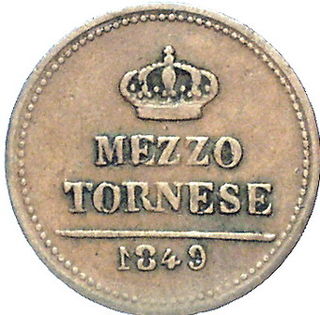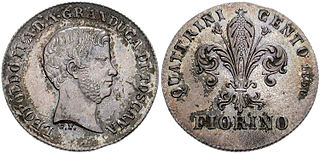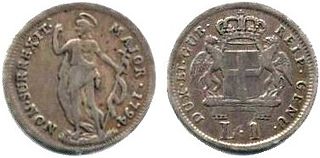
The lira was the currency of Italy between 1861 and 2002. It was introduced by the Napoleonic Kingdom of Italy in 1807 at par with the French franc, and was subsequently adopted by the different states that would eventually form the Kingdom of Italy in 1861. It was subdivided into 100 centesimi, which means "hundredths" or "cents". The lira was also the currency of the Albanian Kingdom from 1941 to 1943.

The scudo was the name for a number of coins used in various states in the Italian peninsula until the 19th century. The name, like that of the French écu and the Spanish and Portuguese escudo, was derived from the Latin scutum ("shield"). From the 16th century, the name was used in Italy for large silver coins. Sizes varied depending on the issuing country.

The lira was the currency of the Kingdom of Sardinia between August 6, 1816, and March 17, 1861.
The florin was the currency of Lombardy-Venetia between 1862 and 1866.
The lira austriaca was the currency of the Kingdom of Lombardy–Venetia.

The ducat was the main currency of the Kingdom of the Two Sicilies between 1816 and 1860. When the Congress of Vienna created the kingdom merging the Kingdom of Naples and the Kingdom of Sicily, the ducat became at par a continuation of the Neapolitan ducat and the Sicilian piastra issued prior to 1816, although the Sicilian piastra had been subdivided into 240 grana. In the mainland part of the kingdom, the ducat also replaced the Napoleonic lira.

The Tuscan fiorino was the currency of Tuscany between 1826 and 1859. It was subdivided into 100 quattrini, a local currency made by four denari. There was an additional denomination called the paolo, worth 40 quattrini, in circulation.

The lira was the currency of the Grand Duchy of Tuscany until its annexation by Napoleonic France in 1807. After that year, it unofficially remained in circulation thanks to its silver value until the restoration of Tuscan independence in 1814. It was finally abolished in 1826.

The Roman scudo was the currency of the Papal States until 1866. It was subdivided into 100 baiocchi, each of 5 quattrini. Other denominations included the grosso of 5 baiocchi, the carlino of 7+1⁄2 baiocchi, the giulio and paoli both of 10 baiocchi, the testone of 30 baiocchi and the doppia of 3 scudi.

The lira was the currency of the Papal States between 1866 and 1870. It was subdivided into 20 soldi, each of 5 centesimi.
The lira was the distinct currency of Venice until 1848, when it was replaced by the Italian lira. It originated from the Carolingian monetary system used in much of Western Europe since the 8th century CE, with the lira subdivided into 20 soldi, each of 12 denari.
The scudo was the currency of Milan until 1806. It was subdivided into 6 lire, each of 20 soldi or 240 denari.
The lira was the currency of the Republic of Lucca until 1800 and again of the Duchy of Lucca between 1826 and 1847. It was subdivided into 20 soldi, each of 3 quattrini or 12 denari.
The piastra was the most common silver coin of the mainland Kingdom of Sicily, also known as the Kingdom of Naples.
The lira was the currency of the mainland part of the Kingdom of the Two Sicilies, known as the Kingdom of Naples, between 1812 and 1813.

The Ticinese franco was the currency of the Swiss canton of Ticino between 1813 and 1850. It was subdivided into 20 soldi, each of 12 denari, similar to the British pounds, shillings and pence system. It was worth 1⁄4th the French silver écu or 6.67 g fine silver.
The scudo was the currency of the island Kingdom of Sardinia until 1816.

The scudo was the currency of the Piedmont and the other mainland parts of the Savoyard Kingdom of Sardinia until 1816.

Italy has a long history of different coinage types, which spans thousands of years. Italy has been influential at a coinage point of view: the medieval Florentine florin, one of the most used coinage types in European history and one of the most important coins in Western history, was struck in Florence in the 13th century, while the Venetian sequin, minted from 1284 to 1797, was the most prestigious gold coin in circulation in the commercial centers of the Mediterranean Sea.

The Genoese lira was the currency of the Republic of Genoa until 1797.












